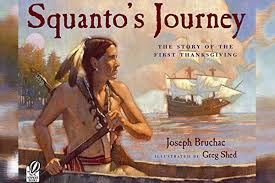
The story of Plymouth Colony in the ‘New England’ sector of ‘Turtle Island’ is an odd case where history really gets weird. Not only does it move in switchbacks and spirals, but some parts also seem like the creations of Hollywood screenwriters of spy yarns, romances, and costumed adventure stories. Some of the parts of the story we learned as children are even true, but told at the expense of a context ‘for adults only.’
The story begins in 1600 with a young man named Tisquantum of the Patuxet tribe, living near what is now Plymouth and Cape Cod. The Patuxet were a subset of the Wampanoag people, who covered a wider area in what is now Rhode Island and Massachusetts. (If you think ‘Tisquantum’ sounds like ‘Squanto’ of our elementary school Thanksgiving tales, you’re right. It’s the same guy.)
One tale has Tisquantum captured in 1605, along with four other young men, by an English adventurer, Captain George Weymouth. ‘Squanto’ is taken to Spain and traded off to Sir Ferdinando Gorge, where he works a short time, escapes to England, learns the language, at gets a job on a fishing ship headed for Newfoundland. Once there, he heads back to his people near Cape Cod. There is no hard evidence to prove this story, save for a claim by Gorge, who did hold several natives traded to him by Weymouth.
What is true is in 1614, an English ‘explorer,’ Captain Thomas Hunt, attacked the Patuxet tribe. He ravaged and looted them, taking several captives, including Tisquantum, back to Spain and selling them. Tisquantum managed to escape to England, where he did learn the language and some sailing skills, and in 1619, he got on a crew headed back to the New England area.
When he did reach home, however, he found his Patuxet tribe entirely wiped out by diseases that followed Hunt’s attack. Tisquantum was a member of the priestly-warrior strata of his tribe and mourned their loss and thus bore his status as the ‘last of my people.’ He went to live with the nearby Wampanoags.
The story now flips back across the Atlantic to Holland. A large number of English religious dissenters, known as the “Brownists,” had taken refuge in Leiden, Holland. But given their intolerant and cantankerous ways–militant opposition to all things Catholic–the Brownists had worn out their welcome. They bought two ships, the Speedwell and the Mayflower, to take them to Virginia. The Speedwell proved unable to make the voyage, so ‘the Saints, ’ as they called themselves, gathered a smaller contingent, joined a more secular grouping called ‘the Strangers,’ and took sail.
The trip was horrific. The Mayflower was designed for cargo, not people, and the hold became squalid and disease-ridden. Several died along the way, but one was born. Driven far off course by storms, they wound up far from the extreme northern reach of ‘Virginia’ (what is now New York harbor). They were required to disembark at Cape Cod and build shelters in the ruins of the old Patuxet village. They barely survived, mainly by finding and looting Indian cornfields nearby and catching fish and game.
But the ‘Saints’ were still in a terrible way and dying off. Just at this point, straight from central casting, entered Squanto, who walked into their settlement and proclaimed, ‘Welcome, Englishmen!’ in a clear version of their own tongue. The saints and strangers were amazed and divided about whether he was an angel or the devil. But what followed is partly well-known: Squanto took pity and helped them to survive, and at very early spring, taught them how to use fish to grow the ‘three sisters’–corn, beans, and squash–along with other survival skills. The next year they held a ‘thanksgiving’ feast. So without this tangled tale, there would have been no Plymouth colony.
Squanto’s primary role soon became interpreter and diplomat between the Saints and other Native tribes. There was mixed Native opinion as to what to do about the steady trickle of English settlers. Some wanted to wipe them out altogether, correctly assessing they would soon want everything. Others, including Massasoit, a major sachem of the Wampanoag, were willing to consider coexistence and trade. The English kept pressing for more land after Squanto died of an illness, and by 1649, Massasoit agreed to a ‘last straw’ concession of some 14 square miles to Myles Standish.
Massasoit soon died, and by 1662, his second son, Metacom, took charge. Metacom either took or was given the name ‘King Phillip.’ He eventually tired of English encroachments and began an all-around resistance known as ‘King Phillip’s War.’ But the English numbers and resources were too great by this time, and the Native peoples retreated to distant areas. Metacom set up camp and held out for several years in the great Assowamset Swamp in southern Massachusetts. The English forces finally killed him in 1676. His body was quartered and hung from the trees. More to come.
(Note: one ‘source’ used here was the National Geographic two-part film, ‘Saints and Strangers.’ Despite some bias and Hollywoodisms, it gets many things right and is worth watching.)